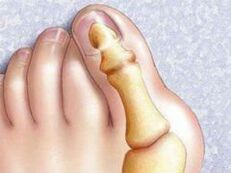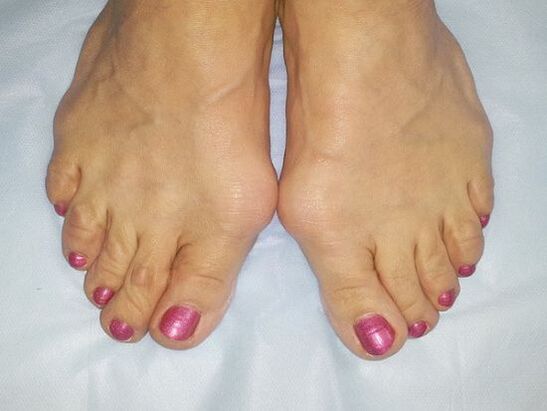
Hallux Valgus is so common that there are more than four hundred options for surgical solutions to this problem in medical practice.Of course, not all interventions have had equal success and have completely solved the patient's problem, therefore, in modern practice, the most progressive intervention options remain in which patients have a great chance of recovery.Today, Hallux Valgus surgery focuses on being as invasive as possible, combined with a good therapeutic effect of the intervention.
Testification
Hallux valgus is not just a problem for adults;It can also occur in children.The formation of a lump of the big finger in the first stage does not bother patients until acute pain occurs, problems with the choice of shoes and periodic inflammation of the bone.At this stage, most patients try to relieve pain using traditional methods.Various compresses and baths only prolong the course of the disease and lead to the only correct solution for deformation of Hallux Valgus - surgery.
The operations for the operation are:
- increased pain in the big toe;
- chronic inflammation that cannot be stopped, constant swelling;
- skin damage in the area of valgus curvature (cracks, soup, ulcers);
- The Valgus Plan with a severe joint curvature with the big toe;
- inability to support patients with conservative methods;
- the appearance of a limping gait;
- Limit of motor activity in the foot.
Doctors insist that the thumb of valgus is extremely surgically, as most patients are treated at the stage of the disease when it is not possible to correct the pathology conservatively.At the same time, if not treated, Bunions will eventually lead to redistribution of the load of other fingers, leading to the second to the fifth fingers to suffer and become crooked.Only with timely surgery can such complications be avoided.
Preparing for the intervention
During the Hallux Valgus operation, serious preparation in the orthopedics is performed.The patient undergoes all the necessary tests.The key is a blood test, the results of which are important for the exclusion of signs of an inflammatory process in the body.
In some cases, the standard list of tests can be supplemented by determining the level of hormones and cancer markers if doctors suspect the development of a malignant process in the foot.
A mandatory stage of orthopedic surgery is X -ray diagnostics - during the study the images are made in two projections to determine the nature of the deformity and the severity of pathological disorders.
In difficult cases, doctors may resort to magnetic resonance imaging or computed tomography.Such a study gives more accurate results.Based on the test results, doctors decide which method is best to perform the operation.
Classification of Surgical Interventions
All operations for Valgus can be divided into two large groups - minimally invasive operations and reconstructive interventions.The first type of foot surgery is characterized by low trauma.
Operations are used to a limited extent - only in the initial stage of the development of the disease, if the deformity is insignificant and in the presence of benign growth of cartilage tissue, which can be easily removed by surgery.In all other cases, minimally invasive operations do not solve the patient's problems.
Most minimally invasive interventions are performed quickly and do not cause complications.The scars after this operation are minimal.The doctor makes two to three punctures for the intervention, the length of which does not exceed 0.5 cm.After these operations, the skin recovers very quickly and the damage period is up to two weeks.
When performing reconstructive interventions, the volume of soft tissue damage is more significant.However, a huge advantage of surgery is that they help to eliminate even significant deformities of the feet and help with severe curvature.The incision during the reconstructive intervention reaches up to four centimeters and is located on the medial side of the foot.With this type of surgery, doctors completely restore the anatomical position of the big toe.
You can also look at the operations depending on the location in which they are performed.There are three groups of interventions - on soft tissues, bone tissue and combination surgery.When performing interventions on soft tissues, deformation of valgus can only be eliminated if there is no deformation of the metatarsal head.During such an intervention, the doctor works exclusively with soft tissues - tendons, muscles, bursa.
With surgery on bone tissue, it is possible to correct deformations of second and third degree.The intervention involves feeding part of the bone or performing an osteotomy.In combined surgery, the intervention is performed in both soft tissue and bone.But the capabilities of such surgery are wider - doctors can simultaneously eliminate bone growth and perform plastic surgery of the ligament.
Operational techniques
Bunions can be eliminated using several surgical techniques, each of which has its own advantages and is selected for certain indications.
Operation McBride

During the surgery, McBride was cut into the first intermetatarsal space exactly at the level of the heads.Using brackets, the doctor pushes the soft tissues at a distance and makes a cut in the intermetergal ligament, which is located on the surface.The surgeon then gains access to the tendon of the muscle, which is responsible for the abduction of the first finger - it is mobilized and sewn with special seam material - Vicryl.
The doctor then works with the sesamoid bones;It crosses the deep ligament, which is attached to the sesamoid bone, thus eliminating its subluxation.Then the capsule of the metatarsophalangeal joint is broken down on the outer surface, after which a cut is made on the inner surface of the foot, with a length of approximately 5-6 cm, through which the nerve is isolated and harvested from the side.
The dissection of the capsule is made in the form of an English letter V and its tip is directed to the thumb.Homan's hooks are placed above the bone and below it and removing the cartilage growths on the head of the metatarsal bone.If this is not done, patients will experience joint pain in the future.
In the future, the development of the operation can be done in two ways, depending on the need for osteotomy.In osteotomy, it is necessary to use a pin that will attach the tendon to the bone fragments.In the last stage, excess capsule tissue is removed, plastic surgery is performed with a certain tissue tension, after which the surgeon sews the edges of the wound and heals its surface.
This technique was offered more than eight decades ago, but to this day the operation has not lost its relevance.In order to prevent relapses after intervention, patients are advised to wear special orthopedic shoes after surgery.
Seri method
Surgical technique, using the minimally invasive technique of Seri, was proposed in 1998 by surgeon Cesare Faldini.It is now actively used in the surgical practice of doctors in many countries.It is a low -traumatic procedure and is effective in the initial stage of the disease and with a moderate curvature of the valgus of the foot when the angle of deviation of the big toe does not exceed more than forty degrees.
Reference!The surgery is not performed due to severe arthrosis.Patients can also be denied this type of intervention if the first metrissophalangeal joint is unstable.
Leg surgery is performed with local anesthesia.The doctor cuts in the projection of the head of the metatarsal bone of the big finger, opens the joint the capsule and performs an osteotomy with a special file or chisel.During this procedure, it is possible to achieve a more redistribution of the load on the distal part of the metatarsal bone.
During the surgical procedure, doctors use Kirschner wires to create the correct position of the thumb - they are placed in the medial side of the surface in a sloping direction, after which the doctor manually moves the finger and placed it in the desired position.The operation during the rehabilitation process requires wearing a cast - it is applied for at least two weeks.The needle is removed after about 1-1.5 months.
Chevron
Shevron technique is used for minor deformation if the angle is smaller than 17 degrees.The main condition for such intervention is the lack of arthrosis and other major changes caused by the foot valgus.
Surgical treatment is performed as follows: at the initial stage the doctor cuts the skin just above the metatarsophalangeal joint of the foot.The shortened connections and the joint capsule itself are highlighted.Usually, degenerative changes in tissues and ligaments cause deformation of the thumb.Calus on the joint is removed with the help of a chisel or saw.
A cut is made on the metatarsal bone at the level of the head, it is shifted out and placed under the sesamoid bone.Phalanx is then secured with the help of screws or wires and the capsule is closed.Titanium screws do not require removal after surgery, but the wires are removed three months after surgery, unless it is necessary to do so early.
Scarf

In most patients, the bunion can be removed using a scarf osteotomy.This operation is performed for moderate deformation of Valgus on the first finger.Today, surgery is the most universal method of treating Valgus;It has many advantages over other methods.
The positive aspects of the operation are as follows:
- During the procedure, it is possible not only to displace, but also to rotate the head of the metatarsal bone, which allows a person to achieve a more progressive result than with other surgical interventions;
- If the size is insufficient, the doctor may perform a bone extension procedure;
- With Varus deformation, the bone can be displaced to the medial side;
- To reduce the load on the inside of the foot and the area of the first toe, you can move the bone slightly down and the side;
- If necessary, you can shorten the length of the bone;
- When the joint is predicted, the bone elements can rotate.
The surgery is performed in spinal anesthesia.The surgeon cuts on the inside of the foot from the beginning of the toe to the beginning of the metatarsal bone.Then cut the zigzag on the side of the bone of the first finger, after which the head of the bone is shifted to the desired position, its angle changes.At the same time, the doctor also changes the location of the tendons that are attached to the thumb.
The deformed joint capsule is then separated from the outside and the bones are fixed in the required position with the help of titanium screws.Usually the fasteners are not removed;If they do not cause discomfort, then patients continue to carry screws.Rehabilitation after surgery takes three to six weeks.Immediately after the intervention, patients are advised to wear a special orthosis or bar in which it is necessary to load the foot as early as possible.The bar is worn throughout the recovery period.
Laser intervention
Removing Hallux Valgus with a laser is also possible, but patients should not hope for this method of surgery.Although minimally invasive and the most tender, it is used exclusively in the early stage of the development of the pathological process.
The undeniable advantage of surgery is the small incision that doctors make close to the largest point of bone convexity.After healing, such an injury is virtually invisible, allowing maximum restoration of the aesthetics of the foot.Using a laser, doctors are able to perform limited interventions:
- Performing exotectomy - with the help of a laser, part of the cartilage growth, which is formed in the early stage of Valgus, is removed;
- Make an osteotomy with a large incision - during surgery, the proximal phalanx of the first finger is removed;
- Perform arthroplasty for resection - the joint surfaces of the metatarsal bone and part of the phalanx of the large finger are removed.
Laser removal is usually done in clinics where there is special equipment.Recovery after surgery is minimal - patients can walk normally after just a few weeks.
The only downside to laser intervention is that the incorrect bone position cannot be corrected, but it is only for the required parameters.In this case, patients are at risk of relapse.
Arthrodesis
Valgus removal surgery with the help of arthrodesis is rarely used today, but sometimes it is the only way for patients to get rid of valgus on the big toe.Surgery is one of the most radical methods of intervention.
With the help of such surgery, it is possible to remove the base of the phalanx of the first toe and fix the toes together with special screws.
Important! During the operation, the main goal is achieved - eliminating deformation and giving the joint the correct position, but not all patients become comfortable after such surgery.
There are serious contraindications in the intervention:
- vascular atherosclerosis and other bloodshed;
- diabetic leg;
- Polyneuropathy.
With arthritis and arthrosis, patients can also be denied surgery if the joints are highly deformed, destroyed or constantly inflamed.In this case, patients will be advised to undergo minimally invasive surgery.
Among the complications of surgery, the following pathologies may occur: severe pain, discomfort due to structures for attaching titanium installed in the bone, and limping.Rehabilitation after the intervention lasts eight weeks.It is necessary to walk in the cast only during the first days after surgery - this is necessary to fix the elements.You can use the Baruk trunk.These are specially designed orthopedic shoes that will relieve the stress of the operated leg.
Examinations
If the patient is undergoing surgery to eliminate Valgus, he or she can read reviews and understand what types of interventions are performed and how effective they are.Here are some similar opinions:
"Last year, I had to finish my career as a ballerina due to the deformation of Valgus on Hallux. We did it using the scarf method, everything looked good, but the foot still hurt when exercised."
"I've been suffering from Hallux Valgus for a long time, but I didn't dare to undergo surgery. I had a complex arthrodesis, the recovery took more than two and a half months, but after the surgery it was much easier. Now I can go without a cane and have no pain."
"The bone of my leg is hereditary - my mother and grandmother also suffered from gout. I decided to do surgery as soon as the first signs appeared. The operation was performed with the help of a laser, all the unnecessary outgrowths were removed from me, now my leg looks normal, but the doctors told me to observe possible relapses."
Hallux Valgus operations in most cases allow a person to solve the problem with a bunion on the finger.When the first signs of Valgus appear, you should not delay treatment - the best results appear at an early stage in the development of the disease.























